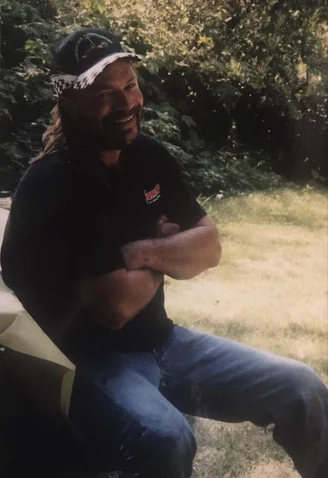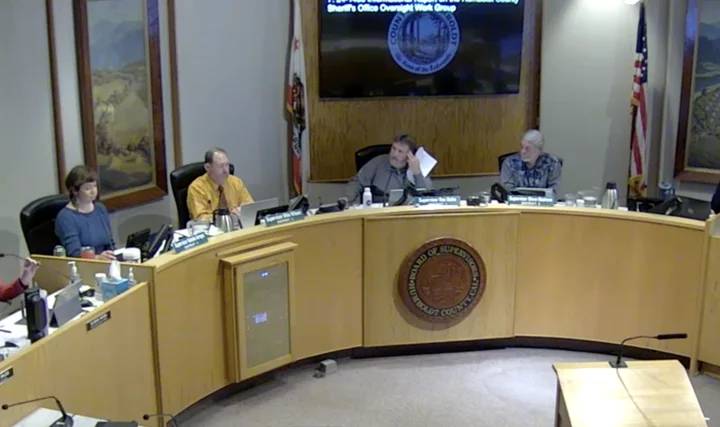Weird Deputy Staking Out Your Block? He Might Just be Testing the Sheriff’s Office’s New Radio System
LoCO Staff / Wednesday, Oct. 30, 2024 @ 10:01 a.m. / Crime
Press release from the Humboldt County Sheriff’s Office:
Beginning last week and continuing through the Thanksgiving holiday on Nov. 28, the Humboldt County Sheriff’s Office (HCSO) is in the process of testing a new radio system throughout the county. This may result in patrol vehicles parked or driving in remote, rural areas; we would like to encourage the public not to be concerned if you see a patrol vehicle in your area.
This radio system will be a digital upgrade to our current analog system, and it is compliant with new regulations set forth by the Federal Communications Commission (FCC).
BOOKED
Yesterday: 3 felonies, 14 misdemeanors, 0 infractions
JUDGED
Humboldt County Superior Court Calendar: Today
CHP REPORTS
Us101 N / Herrick Ave Onr (HM office): Assist with Construction
ELSEWHERE
Growing Pains, with Nick Flores: #228 - Family, Grief, and Creative Growth with Malachi Levvi
RHBB: Major Heat Risk in Inland Areas This Weekend: Prepare for Triple-Digit Temperatures
RHBB: Kneeland School Modifies Elementary School Calendar
MSN News: Trump threatens federal takeover of D.C. after DOGE worker injured in carjacking
California Voters Could Make It Easier for Cities to Build Fire Stations and Fix Hospitals — Right Away
Cayla Mihalovich / Wednesday, Oct. 30, 2024 @ 7:11 a.m. / Sacramento
The Beach Cities Health District in Redondo Beach is asking voters for a construction bond that would pay for improvements at its clinics. It’s the kind of measure that would have an easier path to passage if voters approve Proposition 5 on the 2024 ballot. Prop. 5 would lower threshold for voters to approve bonds, dropping it 55% from today’s 66%. Photo by Jules Hotz for CalMatters
One measure on California’s ballot would make it easier for local governments to build critical infrastructure and affordable housing with borrowed money. Proposition 5 would lower the percentage of votes needed for a bond to pass, from today’s two-thirds supermajority to a 55% majority.
General obligation bonds allow local governments to finance big projects, such as roads, libraries and parks. Over time, Californians pay them off by paying higher property taxes.
A number of bond measures on this year’s ballot could benefit immediately if Prop. 5 passes. Sacramento County has proposed a $415 million bond for fire station improvements. In San Francisco, a $390 million bond would fund improvements to hospitals and pedestrian safety projects. And in the state’s rural and underserved areas, where community hospitals are under imminent threat of closures, a Prop. 5 victory could help them keep their doors open.
“It’s pretty much a no brainer,” said Assemblymember Cecilia Aguiar-Curry, the Democrat of Davis who authored the legislation that put the measure before voters. “Prop. 5 gives local communities an option. Right now, they don’t have anything in the toolbox except for the two-thirds.”
She called the measure, which applies to special districts, cities and counties, an “opt-in” for government officials to have flexibility in how they pass a bond.
“They can either do a two-thirds bond with no guardrails on it, or they can have a bond at 55% threshold with guardrails – with accountability, transparency, citizens’ oversight, independent audits,” she said.
But opponents including Susan Shelley, vice president of communications for the Howard Jarvis Taxpayers Association, said Prop. 5 would authorize countless government entities to put bonds on the ballot, sugarcoating their descriptions and underplaying their costs. Those costs, Shelley said, add up over time.
“Some of the proponents have said this is not a tax increase, but this is an engine for tax increases forever — and it will absolutely result in higher property taxes over and over again and people will start losing their homes if that happens,” she said.
Darien Shanske, a law professor at UC Davis, said the idea that bonds would push somebody into insolvency is “very, very improbable.”
“Our norm as a democratic society is that every vote is equal,” Shanske said. “A supermajority rule is a deviation from that norm. It allows one-third of voters to essentially block what a large majority would like to do.”
Voters are divided over Prop. 5, with 48% percent saying they would approve the measure, according to polling by the Public Policy Institute of California.
The measure is one of the more expensive ones on the ballot. Opponents, including the California Chamber of Commerce and the National Federation of Independent Business, have raised about $30 million. Prop. 5 supporters, such as the pro-development group California YIMBY and the labor organization the California State Building and Construction Trades Council, have raised about $5 million.
California constitution restricts borrowing
The requirement for a two-thirds vote to take on local debt was codified in the 1879 California constitution for local government entities and school boards. Nearly a century later, voters passed the landmark Proposition 13, which restricted property tax assessments and further constrained government spending.
“We vote on (bonds) in the constitution as a matter of policy really because it’s an obligation on future generations,” said Michael Coleman, a California local government finance expert who consults for cities. “Do you want to enter into this contract that commits future generations to paying this off? But future generations also get the benefit of these public improvements.”
Shanske describes it another way: A community passes a bond to build a new bridge. Over the course of multiple generations, people have a chance to enjoy the bridge and pay it off through taxes or tolls.
“But the actual amount of money of a big project divided over a whole community spread over 30 years is typically pretty low,” he said. “The notion of local politicians and local voters deliberately overburdening their property tax base is pretty unlikely, especially since they would also need to get outside investors to sign off on it.”
Shelley from the taxpayers association said the increased charges connected to bonds can ripple out in the economy and affect many people.
“You would see these higher taxes passed through as higher rents, higher consumer prices, even a little small donut shop in a strip mall will have a higher operating cost because the property owner will be passing those higher property taxes right through on the lease,” she said.
Californians have already made an exception once, voting in 2000 to amend the constitution for school bonds, lowering the voter threshold to 55%.
“That really opened up and made it a lot easier for schools to pass these measures. And that’s basically what Prop. 5 would do – bring cities and counties and special districts into the same sort of ability level,” Coleman said.
Coleman tracks votes on general obligation bonds for his work advising California cities. According to him, roughly half of general obligation bonds pass. Of those that fail, about half of them receive over 55% of votes but cannot clear a two-thirds margin. If Prop. 5 passes, he expects to see a 70 to 80% passage rate for general obligation bonds.
“There’s a lot of needs out there,” Coleman said. “I think we’ll see more local governments say, ‘Hey, now there’s a real chance that we’ll be able to get this passed – that the will of the community will be able to be realized at the ballot box.’”
California community hospitals ask for earthquake bonds
Over the years, many housing and infrastructure bonds have failed by slim margins. Those campaigning for Prop. 5 have referenced some near misses. In 2023, a fire protection bond in Santa Cruz County failed despite receiving 66% of the vote. A 2022 affordable housing bond in Berkeley failed with 59% of the vote. In Whittier, a 2017 library bond failed with 66%.
Those misses also include attempts by the Antelope Valley Healthcare District, which has tried and failed three times to pass a bond for its community hospital north of Los Angeles, according to the Association of California Healthcare Districts. In 2022, it failed with 57% of votes.
The district is one of 77 health care districts, a type of “special district,” across California. They were formed in the 1940s to bring critical services such as hospitals, ambulance providers, and skilled nursing facilities to rural and underserved communities.

The Beach Cities Health District medical complex in Redondo Beach on Oct. 27, 2024. Photo by Jules Hotz for CalMatters
“The difficulty, though, is because they’re community-owned and they’re public entities, they’re very limited in how they can finance large-scale or even medium to small size infrastructure projects,” said Sarah Bridge, a vice president of advocacy and strategy at the Association of California Healthcare Districts. “We have really small margins.”
The 33 health care districts operating community hospitals fall under a state mandate to retrofit their buildings for earthquake safety by 2035. But so far, Antelope Valley Healthcare District and many others are still working to secure the funds to make those changes. If they fail to meet the state mandate, they will be forced to close.
At least two health care districts have bonds on the November ballot, including one in Redondo Beach.
From his office window, Tom Bakaly, chief executive officer of Beach Cities Health District, looks out at a sea of asphalt. But that would change if voters in three Los Angeles cities approve a $30 million bond, at an estimated cost of $3 per $100,000 of assessed value for property owners.
The asphalt would transform into two acres of open space for community health and wellness programs, such as yoga and Zumba. In an adjacent corner of the health campus, a youth mental health facility, which has had close to 9,000 visits over the past two years, would expand. And the 1960 hospital would be demolished due to seismic issues.

The Beach Cities Health District Administrative Offices and Shirley Rogers Student Services Center in Redondo Beach on Oct. 27, 2024. Photo by Jules Hotz for CalMatters
“The vision is to create a place where people can come and be well,” Bakaly said. “I think it’s a great opportunity for voters to decide what they want.”
In the small coastal town of Cambria, the city’s Community Healthcare District has proposed a $5.9 million bond to build an ambulance station.
“We consider (our ambulances) our lifeline,” said Laurie Mileur, board member of Cambria Community Healthcare District.
She said that the ambulance crew operates out of a 70-year-old building that’s not designed for 24-hour use. The new building would include a garage for the ambulances, a decontamination space and more storage.
According to Mileur, the bond would cost property owners roughly $50 a year, on average.
“It’s a cup of coffee a month,” she said. “We feel it’s time for the community to step up and share this commitment to our service.”
It’s their second attempt. Two years ago, the health care district’s bond for a new ambulance station failed at 61.4%, a shortfall of roughly 200 votes.
“For a small agency who really doesn’t have the cash reserves that could actually pay for infrastructure, we really rely on bonds. And setting such a high threshold makes it very difficult,” she said. “We’re confident we’re going to get over 60% again. It’s whether or not we can get to 66.7%. It would be heartbreaking if we lost by one vote.”
###
Cayla Mihalovich is a California Local News fellow.
CalMatters.org is a nonprofit, nonpartisan media venture explaining California policies and politics.
OBITUARY: Craig Ray Haberstock, 1962-2024
LoCO Staff / Wednesday, Oct. 30, 2024 @ 6:55 a.m. / Obits
Craig
Ray Haberstock passed away October 12, 2024, at the age of 62.
Craig was born on June 16, 1962, to Raymond and Annette Haberstock.
Craig attended private school growing up. At the age of 16, he started working alongside his father surveying, and later the family opened a construction company as well. Craig worked alongside his father for Haberstock Construction and Surveying for forty years, driving truck and operating heavy equipment. He had a passion for the construction industry, had a great love of animals, and loved his children. In his free time, he loved restoring old cars. You could also find him lying in the yard eating popsicles as he watched the kids perform the lengthy chore list he made Saturday morning, which instilled strong work ethic in each of his children. He was also known as a man who possessed an amazing green thumb, always maintaining a meticulous garden, and taking immense pride in the home in which he raised his children.
Surviving family members:
Annette Haberstock - Mother, Kent Haberstock (Charlie- brother), Cody Haberstock - Son, Daughter in Law - Ashley Stuart, April Haberstock - Daughter, Shane. Craig also had a total of seven grandchildren - Echo, Bailey, Maliah, Rykin, Bryton, Austin, and Major, as well as an aunt, an uncle, numerous cousins, and countless friends who will miss him dearly.
Predeceased family members:
Craig was preceded in death by his grandparents George and Signe Haberstock, as well as his father Raymond George Haberstock.
###
The obituary above was submitted on behalf of Craig Haberstock’s loved ones. The Lost Coast Outpost runs obituaries of Humboldt County residents at no charge. See guidelines here. Email news@lostcoastoutpost.com.
OBITUARY: Alexander V. Winogradov, 1991-2024
LoCO Staff / Wednesday, Oct. 30, 2024 @ 6:49 a.m. / Obits
Alexander V. Winogradov was born on May 10, 1991, in Eureka, to Dale
and Angela Winogradov. Four short years later, he welcomed his baby
sister, Ashlyn. Throughout Angela’s pregnancy, Alex was eager to
meet his new sibling. But upon entering the room and hearing the
cries of his newborn sister, he promptly put his hands over his ears
and asked his mother if she could “put her back in.” Alex’s
personality shone bright, even as a young child. He was, by all
accounts, the perfect baby, constantly smiling and giggling.
Everyone adored holding him, charmed by his joy. He was so captivating, he could have been on the cover of a Gerber magazine — minus the endearing fluffs of hair that made him uniquely Alex.
From an early age, Alex showed remarkable intelligence, excelling in school and in any sport he took an interest in. A natural daredevil, he loved speed and adventure, especially spending weekends with his dad riding dirt bikes. When he wasn’t on two wheels with a motor, he excelled at BMX, though it wasn’t his first-place ribbons that made him memorable. Alex’s sportsmanship was evident whenever he’d stop mid-race to check on someone after a wreck. This generous spirit carried him through his life; even when he had nothing, he would give the shirt off his back. Alex had one of the kindest and most generous hearts of anyone one could hope to meet.
After graduating high school early, Alex set out to find his place in the world, discovering a love for travel. Of all the places he explored, Hawaii remained his favorite. What started as a six-week trip turned into two years, and he often called home to share his awe at the warmth of the beaches compared to the cold sands of California. Alex had a heart for the outdoors, with an unbounded free spirit and a remarkable courage for new experiences. He was unafraid of change, embracing each new adventure with open arms.
Alex passed away surrounded by family on October 23, 2024. Our family’s loss is profound and will be felt for a lifetime. Yet, true to Alex’s nature, his final act was one of immense generosity, he was eligible to be a donor; forever changing the lives of four recipients. Alex is survived by his parents, Dale and Angela Winogradov; his sister, Ashlyn Farrington, and her husband, Ryan; his two beautiful nieces, Isabella and Galilee Farrington; his grandparents, Andrea and Karl Arnold; his great-grandmother, Patricia Wilsey; and numerous aunts, uncles, and cousins — so many that Alex often joked he was blessed with thousands of them.
A memorial service will be held at the Wharfinger Building on November 3 from 11 a.m. to 2 p.m. All who knew Alex are welcome to join and celebrate his life.
In closing, I know without a shadow of a doubt that Alex would want everyone to keep living life fully — to keep exploring, to continue adventuring, to cherish those you love, to seize every opportunity, and to laugh often. If you knew Alex, you know he was always smiling, always joking, and always brightening the days of those around him.
###
The obituary above was submitted on behalf of Alex Winogradov’s loved ones. The Lost Coast Outpost runs obituaries of Humboldt County residents at no charge. See guidelines here. Email news@lostcoastoutpost.com.
TODAY in SUPES: Board and Public Voice Concerns About Wood Pellet Biofuel Project; Sheriff Proposes Advisory Council in Lieu of Oversight Committee
Ryan Burns / Tuesday, Oct. 29, 2024 @ 4:54 p.m. / Environment , Local Government
The Humboldt County Board of Supervisors (from left): Natalie Arroyo, Mike Wilson, Rex Bohn and Steve Madrone. Supervisor Michelle Bushnell was absent.
###
The big topic of conversation at today’s meeting of the Humboldt County Board of Supervisors was a controversial, industrial-scale biomass project being proposed by the Golden State Finance Authority (a joint powers authority) and Golden State Natural Resources (GSNR), a government-linked nonprofit that focuses on forest management and economic growth.
The board heard a presentation from two staff members of the Rural County Representatives of California (RCRC), a state policy group representing 40 counties, including Humboldt.
In short, GSNR is proposing to collaborate with a private bio-energy producer — possibly the U.K.-based company Drax, which has a spotty track record — on a project to convert forest biomass into industrial wood pellet stock for energy production. The Draft Environmental Impact Report (DEIR) for this so-called “Forest Resiliency Demonstration Project” runs a whopping 1,300 pages, not counting the voluminous appendices.
The board agreed to send a letter to the Golden State Finance Authority asking it to extend the public comment period for the DEIR to 90 days so that the public can have additional opportunities to weigh in.
This proposed project would operate at facilities in Lassen County and Tuolumne County, taking biomass (slash and other organic material from forest thinning, orchards, sawmills, etc.) from within a 100-mile radius of each facility, then shipping it to be processed into wood pellets and exported from the Port of Stockton to markets around the world. Up to 1 million metric tons of wood pellets would be produced annually.
The stated goals of the project include improving forest health and mitigating wildfire risk while producing a valuable fuel source in wood pellets, considered by some to be an environmentally superior alternative to coal. (Not everyone agrees. See below.) But county supervisors and members of the public, including quite a few representatives from local environmental groups, voiced serious concerns about the environmental impacts of such a project.
Fourth District Supervisor Natalie Arroyo had some questions about the draft environmental document, noting the massive scale of the project, including its workforce component, and asking whether prescribed burning was considered as an alternative method of forest management. In response, RCRC staff said the organization supports prescribed fire but doesn’t consider it an either/or choice with the wood pellet project.
Fifth District Supervisor Steve Madrone spoke at length, saying he’s skeptical of the project “for a lot of reasons.” Specifically, he mentioned the fossil fuel costs and asked why a smaller project hadn’t been considered as an alternative. He also expressed concerns about the potential health impacts of manufacturing the wood pellets, including dust exposure, on the community in Stockton. And he questioned the project’s long-term fiscal sustainability, noting that the wood pellet industry is dependent on intermittent subsidies.
“I’m not anti-biomass, by any means,” Madrone said, but he advocated for a smaller-scale project. He also said that if Drax is chosen as the private-industry partner for this project, it would be “a public relations nightmare.”
First District Supervisor and board chair Rex Bohn, who previously served as chair of RCRC, expressed support for the project, citing the closure of countless sawmills, the need for wildfire management and the potential jobs for people in Lassen and Tuolumne counties.
He also voiced frustration with how long the project has taken to get to this point, saying it’s “because we keep having these public meetings and questions keep getting asked.”
“Hopefully we’ll be able to move forward on this … because this is an answer to the problems we have,” Bohn said.
Yana Valachovic, the county’s forest advisor and University of California Cooperative Extension director, urged the board to consider the need for both prescribed fire and management tools to deal with the woody vegetation that functions as surface fuels.
“How do you deal with all the material that’s been built up?” she said. “This is one alternative, and it’s one pathway.” She also addressed the impacts of wildfire smoke, saying, “I appreciate any project that’s going to be able to help make an impact at that scale and help reduce the potential smoke impacts that are going to come our direction.”
During the public comment period, former county supervisor candidate Gordon Clatworthy said wood burning actually produces more greenhouse gases than coal. (Some smokestack emissions tests support this statement.) “I don’t think this project is right for our community, and I also feel that it undermines our climate goals,” he said.
Tom Wheeler, executive director of the Environmental Protection Information Center (EPIC), said a longer public comment period is fully justified for this “extraordinarily complex and controversial project.”
Following up on a comment from Supervisor Madrone about how the biofuel industry can act as the “tail that wags the dog” of forest management, Wheeler remarked, “We’ve seen that in the American Southeast, where we’ve seen logging of whole trees to supply the biomass plants.”
Fellow environmental activist and author Greg King said, “It is worth noting that wood-fired biomass is a multi-billion-dollar industry, and it’s quickly growing.” King said the GSNR website is filled with “the grim language of greenwashing … [but] what is being proposed by GSNR and Drax and the state of California … is anything but green. Rather, it’s a recipe for disastrous and perhaps final pillaging of our already suffering Western forests.”
Numerous other environmental advocates expressed similar opinions, with some saying the county should refuse to support the project altogether.
Third District Supervisor Mike Wilson made the motion to send the letter requesting a longer public comment period, and he said, “I think there’s probably a larger conversation as we move forward about biomass fuels and their large-scale development and export.”
Bohn seconded the motion, and it passed unanimously.
Afterward, Madrone asked whether GSNR already has a memorandum of understanding with Drax. (There is one, he was told, though it’s non-exclusive and non-binding.) After some more discussion, Madrone wound up making a motion for the board to oppose the project altogether.
After some push-back from his fellow board members, however, Madrone agreed that taking such a stance before the EIR is complete would be premature.
Sheriff’s Office oversight
Earlier in the meeting, the board revisited the open question of whether or not to create a civilian oversight committee for the Humboldt County Sheriff’s Office, as recommended by this year’s Civil Grand Jury.
The county’s supervisors proved to have substantively divergent views of this notion when the recommendation was first discussed, back in July. At that meeting, Bohn defended the county’s “great law enforcement” agency, and he and Bushnell argued that Sheriff William Honsal can always be held accountable at the ballot box.
But Arroyo, Wilson and Madrone voiced support for establishing either a civilian oversight board or an inspector general with subpoena power, arguing that such a body would improve public trust, transparency and accountability.
At a subsequent meeting, in August, Honsal himself urged the board to reject the Grand Jury’s recommendation, saying his office is already transparent with the public and suggesting that if there are serious allegations of misconduct they would be investigated by existing agencies, including the California Commission on Peace Officers Standards and Training (POST), the Department of Justice, the District Attorney, the Board of Supervisors, the Human Rights Commission and the Grand Jury.
The board punted on a decision at that meeting, instead appointing a working group consisting of Arroyo, Bushnell, Honsal and County Administrative Officer Elishia Hayes.
At today’s meeting, Hayes reported that the group met just once since then, but its members quickly agreed that a Sheriff’s Advisory Council could be created. They’re working to develop a proposal on the specifics to bring back to the board at a later date, and according to Hayes the idea came from Honsal himself.
The advisory council “would be comprised of up to seven members,” Hayes said, with the existing four-person working group bringing forward recommendations for other appointees.
Arroyo said this advisory council would be similar to the one established by the City of Eureka. It would offer perspectives from “outside the law enforcement space,” she said, but it wouldn’t be quite what the Grand Jury recommended — a civilian oversight committee.
“So we’re going to continue to explore that and go forward with additional information gathering,” Arroyo said.
Bohn was still skeptical.
“We had one of these 12 years ago, and we met downstairs by the elevators. And it kind of went by the wayside because of lack of anything to do,” he said.
Madrone advocated for a committee with more teeth, saying the kind of oversight needed is beyond the skills of a volunteer citizens group.
“So I think this is a great first step, but it won’t satisfy myself and I believe a lot of the public in regards to wanting to have deeper oversight into critical incidents so that we can learn from them and improve … ,” he said. “I said this before, but I’m not sure that we can afford not to have this kind of group, even if it costs us money to hire a consultant who is expert in this realm … because we have a lot of lawsuits, and they cost a tremendous amount of money.”
The board unanimously agreed to let the working group continue its efforts toward developing the advisory council.
###
PREVIOUSLY:
- In First Report of the Year, Grand Jury Recommends Civilian Oversight Board for the Humboldt County Sheriff’s Office
- County Supes Have Differing Views on the Merits of Civilian Oversight of Sheriff’s Office But Postpone Decision on Grand Jury Recommendations
- TODAY in SUPES: Sheriff Honsal Chafes Against Call for Civilian Oversight; Board Considers Responses to Civil Grand Jury, Denies Blocksburg Glamping Project
Unidentified Driver of Dodge Challenger Dies After Vehicle Goes Off a Cliff and Erupts in Fire in Hoopa
LoCO Staff / Tuesday, Oct. 29, 2024 @ 1:21 p.m. / News
###
PREVIOUSLY: CHP Watch
###
Press release from the California Highway Patrol:
On October 27, 2024, at approximately 1848 hours, the California Highway Patrol’s (CHP) Humboldt Communications Center received a call of a solo vehicle crash on Matilton Road, just south of Loop Road.
CHP Humboldt Area units responded to the scene and, upon initial investigation, it was determined the driver of a 2016 Dodge Challenger was driving south on Matilton Rd., at an unknown speed, just south of Loop Rd.
For unknown reasons, the driver turned the Dodge unsafely to the left causing it to go off of the east edge of Matilton Rd., and down a cliff. The Dodge impacted multiple trees and ultimately came to rest at the bottom of the cliff.
After coming to rest, the Dodge caught fire and became fully engulfed. The driver, and only occupant of the Dodge, was still inside when it caught fire and was unfortunately pronounced deceased on scene.
Personnel from the Hoopa Volunteer Fire Department, the Hoopa Tribal Police Department, the Humboldt County Sheriff’s Office and the California Highway Patrol assisted with this traffic crash.
The California Highway Patrol, along with the Humboldt County Coroner’s Office, are actively working to confirm the identity of the involved party.
The use of alcohol and/or drug(s) is unknown at this time.
The CHP Humboldt Area office is continuing to investigate this crash and asks anyone who may have information related to the investigation to call the office at 707-822-5981.
(VIDEO) Goodbye, Schatzi’s! Maybe the Real Hidden Treasures Were the Friends We Made Along the Way
Isabella Vanderheiden / Tuesday, Oct. 29, 2024 @ 7:05 a.m. / :)
It’s the end of Humboldt’s Schatzi’s era | Video/Photos: Andrew Goff
###
After more than 15 years of keeping Humboldt stocked in crystals, Bob Marley posters, duffel bags, bongs, tie-dye bellbottoms and swords, Schatzi’s Hidden Treasures is closing up shop, marking the end of an era at Eureka’s Bayshore Mall.
Schatzi’s first entered the Humboldt consciousness in 2009 when Christof Timotek Schneider-Reuter — “Timo,” to friends — began selling tapestries and incense at a kiosk inside the Bayshore Mall. Mall patrons enjoyed his eclectic wares so much that he decided to expand his business to a storefront. Schatzi’s has relocated a few times over the years, but its current (and final) home is situated near the entrance to Ross Dress for Less, across from the Department of Motor Vehicles.
Now, if you know me, you know I love the Bayshore Mall. I have spent many, many Sunday afternoons bopping around the mall, browsing the shops while munching on a pretzel dog and wondering how the hell F.Y.E. manages to stay in business. (Are Funko Pops!™ the glue that holds it all together?) During these mall outings, I almost always pop into Schatzi’s to admire the trinkets and bask in the Humboldt-flavored chaos of it all.
In my mind, Schatzi’s is a near-perfect microcosm of Humboldt County’s counterculture. Sure, it caters a bit more to festival-goers and New Age hippie types, but something about it captures the eccentric spirit of this quirky little place we call home. I mean, where else can you get a locally crocheted banana slug hat, handmade Yurok jewelry, a Bigfoot t-shirt, and an enormous duffel bag to transport your weed? Exactly.
I dropped by the Bayshore Mall last week, along with the Outpost’s Andrew Goff, to learn more about Schatzi’s impending closure and the store’s legacy here in Humboldt. As we made our way past the “lucky” bamboo and tiny fairy statues, we spotted the owner, Schneider-Reuter, chatting with one of his employees. He offered us a warm, German-accented welcome and took us on a tour of his store.
Looking up at the illuminated sign above the entrance to his store, Schneider-Reuter told us “schatzi” is a German term of endearment that roughly translates to “treasure,” or a sweet nickname you’d call a loved one.
“Treasure’s Hidden Treasure, it’s kind of like a double entendre,” he said. “It’s cute. We’re all schatzis, right? It could be you, it could be your grandfather, your grandmother, your dog, whoever. We’re all schatzis.”
Since Schatzi’s inception over a decade ago, Schneider-Reuter said he has always tried to facilitate a space that “makes everybody feel welcome.” That sentiment is reflected in the huge array of products he offers.
“If you tell us ‘I really want, hmm, hmm, hmm’ I will try to find it,” he said. “I let the customers tell us what we sell, you know? I mean, there are certain things we’re not going to sell, like a Confederate flag or something like that. We do have some values that are important to us, like inclusivity.”
The crown jewel of Schatzi’s – if I may be so bold – sits in the store’s front window. The “Iron Giant,” created by local sculpture artist Richard Kistler, is an 11-foot-tall bong made of 850 lbs of steel. The piece is currently listed for sale on Facebook Marketplace for $1,995.00.
“I’m trying to find a new home for it. I think it should go in the middle of the Arcata Plaza where McKinley used to be,” Schneider-Reuter joked, adding that he’s dropped the price by about $4,000 since he was originally listed. “I started with more because I paid more for it, but at this point, I’m open to whatever.”
Unfortunately, the behemoth bong is not operational. (Sorry, stoners!) However, Schneider-Reuter said a friend had told him it might be possible to make a smoker out of it.
“It’s a really fun piece,” he added. “I just want it to go somewhere where it will be appreciated.”
Another inexplicable feature of Schatzi’s Hidden Treasures is its collection of large and extra-large duffel bags. I have made my own assumptions about the duffel bags over the years, but I decided to ask anyway. “What’s all the luggage for?”
Surely anticipating my question, Schneider-Reuter’s face lit up and he told me he had taken over luggage sales from a man named Lee when he decided to close his business.
“He came to me and he said, ‘Hey, Timotek. I’m leaving but you need to sell duffel bags when I leave.’ Why do I need to sell duffel bags? I had no idea, but I trusted him,” Schneider-Reuter explained. “I bought his leftover inventory and oh my gosh, I think I sold 15 pallets of duffel bags that year, easily. Those are the really big bags. You can put 50 units in those bags.”
“Units?”
“50 pounds of weed,” he laughed. “And then people would take those [bags] and deliver them to wherever they sell their product. It’s a one-way use so they would always come back at the next harvest when they needed more bags.”
As you can imagine, duffel bag sales aren’t what they used to be. When the statewide cannabis industry collapsed a few years back, Schneider-Reuter saw a huge drop in business.
“That [was] a big part of my success,” he said. “With that missing, I mean, that’s the bottom line.”
To many, Schatzi’s impending closure will come as no surprise. American malls have steadily declined in the last 20 years – even more so since the COVID-19 pandemic – as brick-and-mortar retailers struggle to compete with online stores.
“We are down 50 percent in sales since COVID,” Schneider-Reuter said. “I think people [have opted] to purchase items online … understandably so. It’s easier for us to sit at home at night and order and choose and compare to get a decent price [for what we want].”
Three years ago, Brookfield Property Partners, the real estate management company that now owns and operates the Bayshore Mall, agreed to foreclose on the shopping center. At the time, it wasn’t really clear what the “friendly foreclosure” would mean for the future of the Bayshore Mall but it seems to be limping along. Several businesses have left the mall since the foreclosure was announced in May 2021, but several others have come aboard in the same time period.
Another big issue is shoplifting. Schneider-Reuter said the mall has seen a huge uptick in retail theft in the years following the pandemic. Mall security is “pretty hands off,” he said, which has put mall employees in the uncomfortable position of policing shoppers.
“Having to ask my employees to be on watch all the time, like, ‘Hey, what’s in your pocket?’ It kind of takes the fun out of retail,” he said. “I’ve seen so many people walk by with arms full of items … and nobody does anything. … I understand if you need a sandwich, no problem. I get it for certain things, but when it comes to a small shop like mine, it’s hard to measure [the impact] because I don’t really know all the things that get taken.”
However, that’s not why he’s closing Schatzi’s. After 15 years of selling trinkets, Schneider-Reuter says he’s ready to free up his time and move on to the next thing.
“It’s bittersweet,” he continued. “I’ve paid my dues, you know, serving the community and selling items in the mall. In my philosophy, there’s a beginning, a middle and an end to everything, and I’m choosing for this to be the end. I don’t want to end up being burned out on it or feeling bitter about it, you know? It’s good to choose your endings so you can start something new.”
Schatzi’s will officially close its doors in January 2025.














